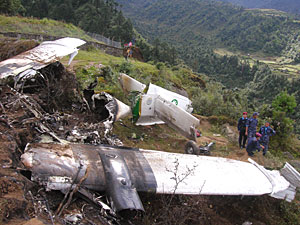 SURAJ KUNWAR |
Nepal is one of those places in the world where a traditionally fatalistic society that hasn't had time to adjust to the outside
world collides head-on with modern technology, often with disastrous results.
The rate of road accidents in Nepal has soared in recent years. Fatalities calculated on the basis of passenger miles is now one of the highest in the world. Building codes, contingency planning or evacuation drills are nearly non-existent in the capital's new high-rise buildings. There is almost no state-level preparedness for earthquakes and their aftermath.
Our rash attitude towards pesticides, food additives, traffic rules, fuel adulteration, household electrical appliances, pharmaceuticals or even activities that directly affect our health (like tyre burning) show that we either don't care or don't know about the consequences of flouting norms that guide technology.
Nepal's civil aviation sector has been flying on a wing and a prayer. Inadequate training and equipment and a combination of carelessness and recklessness have made Nepal notorious for plane crashes.
Since 1990 there have been 18 fatal airliner accidents in which over 400 people have been killed. Analysing accident data shows that most of the crashes were caused by airworthy aircraft flown by disoriented or careless crew into mountains covered by clouds, called Controlled Flight Into Terrain (CFIT) in technical jargon.
Last week's crash of a Twin Otter in Lukla with the loss of 18 lives was just the latest in a long list of CFIT events that have occurred with tragic regularity in Nepal. In November 2006, a helicopter flew into a mountain in eastern Nepal killing 25 people, including most of Nepal's senior conservation experts.
The Canadian-built Twin Otter is a sturdy workhorse, but pilots need to be extra alert when flying to remote STOL airfields, especially during the monsoon. Ten Twin Otters have crashed since 1990, seven of them were CFIT?this is an unacceptably high attrition rate by any standard.
New cockpit avionics that give pilots a 3-D map of the terrain ahead of them are now available, but they are expensive. Ultimately, failsafe navigation aids are of no help if pilots ignore them. Nothing can replace rigorous crew training and strict guidelines on flying in poor visibility in the mountains.
We are culturally prone to leaving too much to chance. Modern technology doesn't forgive mistakes, and we tend to make too many. Alas, the Lukla crash probably won't be the last.


